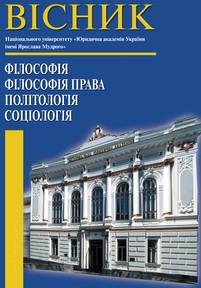ФЕНОМЕНОЛОГІЯ ТВОРЧОСТІ У ЦИФРОВУ ЕПОХУ
THE PHENOMENOLOGY OF CREATIVITY IN DIGITAL ERA
Author(s): Yuliia Vasylivna Meliakova, Eduard Anatoliyovych Kalnytskyi, Inna Igorivna KovalenkoSubject(s): Fine Arts / Performing Arts, Aesthetics, ICT Information and Communications Technologies, Sociology of Art
Published by: Національний юридичний університет імені Ярослава Мудрого
Keywords: digital culture; contemporary art; creative process; digital paradigm; quasi-existence;performance;
Summary/Abstract: The paper aims to discuss the features of art practices and the specifics of art work existence in the digital culture paradigm. The research methodology is determined by the heuristic potential of art and cultural philosophic studies in digital culture combined with the communicative and existential analytics. The characteristics of author’s individual art strategies in the interactive locus of existence is the scientific novelty of the work and allows us to conclude that the interactive media landscape has considerably changed the configuration of art work in culture. Being the projection of the digital ontology of reality and having received unlimited access to communication, an artist primarily demonstrates creative workflow, provides information on the creation and his or her own quasi-existence, avoiding similarity and anonymity. Sometimes process documentation is more important than art itself and it can replace an artwork. Contemporary art is represented not only by finished products (“objects”), but also by relations (the frequency of participatory practices, performance, life experience of the epoch when the artwork was created). These relations enable to implement new rationalization. Owing to the above practices, an artist and a viewer are both actively involved in the creative process of converging design, content and logic of artwork development. The contemporary reality is mediated not only by transcendent or language, but also by new media (partially linguistic, partially pragmatic), being merely fiction, or construct. This is the way of representation that has fulfills a serious ontological function: the subject existence as a homo mediatus is verified by his or her presence in the network. Accordingly, artist’s creativity, as well as his internal world, will be perceived if he is proactive in digital culture.
Journal: Вісник НЮУ імені Ярослава Мудрого. Серія: Філософія, філософія права, політологія, соціологія
- Issue Year: 44/2020
- Issue No: 1
- Page Range: 157-167
- Page Count: 11
- Language: Ukrainian

